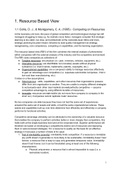1. Resource Based View
1.1 Collis, D. J., & Montgomery, C. A. (1995) - Competing on Resources
At the business unit level, the pace of global competition and technological change has left
managers struggling to keep up. As markets move faster, managers complain that strategic
planning is too static, too slow, and problematic at the corporate level. More and more,
strategic planning focused inward, followed by total quality management as strategy,
reengineering, core competence, competing on capabilities, and the learning organization.
The resource based view (RBV) of the firm combines the internal analysis of phenomena
within companies with the external analysis of the industry and the competitive environment.
The RBV sees companies as collections of:
● Tangible resources: are physical (i.e. cash, inventory, vehicles, equipment, etc.).
● Intangible resources: are identifiable non-monetary assets without physical
substance (i.e. brand names, trademarks, patents, copyrights, etc.).
● Organizational capabilities: are a company's ability to manage resources effectively
to gain an advantage over competitors (i.e. Japanese automobile companies - first in
low-cost lean manufacturing, etc.).
It relies on a few assumptions:
● Heterogenous: skills, capabilities, and other resources that organizations possess
differ from one organization to another. They are unable to employ different strategies
to outcompete each other (real markets are not perfectly competitive → assume
competitive advantage by using different bundles of resources).
● Immobile: resources are not mobile (do not move from company to company in the
short run). Companies cannot replicate rivals' resources.
No two companies are alike because they have not had the same set of experiences,
acquired the same set of assets and skills, or built the same organizational cultures. These
assets and capabilities built up over time determine how efficiently and effectively a company
performs its functional activities.
Competitive advantage ultimately can be attributed to the ownership of a valuable resource
that enables the company to perform activities better or more cheaply than competitors, this
holds both at the single-business level and at the corporate level. Superior performance will
therefore be based on developing a competitively distinct set of resources and deploying
them in well-conceived strategies. For a resource to quality as the basis for an effective
strategy it must pass a number of tests of its value:
1. Test of inimitability (scarcity): inimitability limits competition. If a resource is inimitable
any profit stream it generates is more likely to be sustainable. Inimitability doesn’t last
forever, a resource that is easy to copy only generates temporary value. Inimitability
doesn’t last forever, but it can be forestalled using at least one of the following
characteristics:
a. Physical uniqueness: a resource that is almost impossible to copy (i.e. a
real-estate location).
1
, b. Path dependency: a resource that is difficult to copy because it was created
over time (i.e. consumer trust in a certain product).
c. Causal ambiguity: a resource that is difficult to copy because it is hard to
disentangle either what the valuable resource is or how to recreate it (i.e.
organizational capabilities dependent on particular individuals).
d. Economic deterrence: a resource that is difficult to copy because a sizable
investment is made in the asset, the competitor could still replicate the
resource but because of limited market space this is not feasible (i.e. first to
build a float-glass facility in Eastern Europe is likely to go unchallenged by
competitors).
2. Test of durability (scarcity): the longer lasting a resource is, the more valuable it will
be. This test asks whether the resource can sustain a competitive advantage over
time. Banking on the durability of most core competencies is risky because most
resources have a limited lifetime.
3. Test of appropriability (appropriability): not all profits from a resource automatically
flow to the company that owns the resource. The value is always subject to
bargaining among customers, distributors, suppliers, and employees. Basing a
strategy on resources that are not inextricably bound to the company can make
profits hard to capture.
4. Test of substitutability (scarcity): This is different from imitation. Imitation aims to copy
the valuable resource, whereas substitution aims to replace a valuable resource with
a different solution.
5. Test of competitive superiority (demand): managers often do not assess resources
relative to competitors when evaluating their companies’ resources. Core
competence should not only be an internal assessment but also an external
assessment of what a company does better than its competitors, for which the term
distinctive competence is more appropriate. A way to compare a companies’
resources is by disaggregating them. Only by looking at this level of specificity can
we understand the sources of a company’s uniqueness and measure by analyzing
the data whether it is competitively superior on those dimensions. Disaggregation is
important not only for identifying truly distinctive resources but also for deriving
actionable implications. Sometimes valuable resources are combinations of skills,
none of which are superior by itself but which when combined make a better
package.
Managers should build their strategies on resources that meet the five tests outlined above.
The tests capture how market forces determine the value of resources.
2





